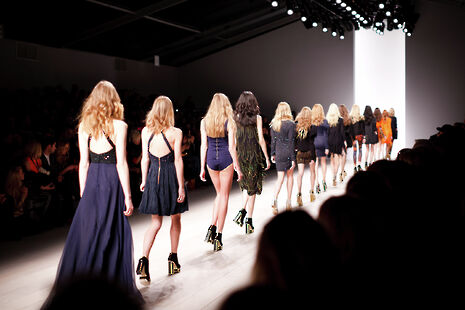A catwalk through time
Jessica Phillips explores the development of the fashion show as spectacle and considers how it is likely to develop in future, faced with the increasing influence of social media and an aseasonal fashion cycle

Fashion week is here and we’re all excited as we get the chance to see the best of current street style and begin to plan our outfits for autumn. But with our modern desire for instant gratification, this delay between us first seeing the clothes on the catwalk and actually being able to wear them ourselves is becoming a problem for the fashion industry. This begs the question: what is the history of the fashion show and how are they changing?
Fashion shows are organised by design houses to show off new collections and the creative vision behind them. The first big fashion shows were held by American department stores in the early 1900s to appeal to their female customers, and it was only in the 70s and 80s that designers began to host independent shows. After several mishaps, due to small and unsafe locations, the Council of Fashion Designers decided to centralise shows and in 1993, New York Fashion Week was born.
"They are a platform to connect to the customers and an opportunity for designers to showcase their creative vision for a fashion collection through their own lens"
Fashion shows are crucial to the industry as they give fashion journalists and buyers an opportunity to view collections and decide what to include in their magazine shoots and orders for the next season. They are a platform to connect to the customers and an opportunity for designers to showcase their creative vision for a fashion collection through their own lens, rather than having been mediated through the perspective of a fashion editor. However, in such a competitive industry the pressure for designers to remain relevant is intense, and with the rise of social media, where success or failure can be determined overnight, this pressure is only increasing.
Fashion shows are becoming more and more about the ‘show’ rather than the fashion as designers try to do something memorable and ‘instagrammable’ with the way they present their clothes. Kanye West’s Yeezy shows, such as Season 4 which was held on Roosevelt Island, are loved by the social media clique for their unique use of static models. The Victoria’s Secret annual fashion show is another great example of how the event bears little relevance to what you see in stores. There is huge hype around it and it is widely televised, with musical acts such as Taylor Swift and Lady Gaga performing in recent years and almost costume-like runway looks.
While the simplicity of a catwalk show does still exist, it’s clear that the current model of fashion shows is outdated in our world of instant gratification. In fashion, everyone talks of the ‘moment’ but it is difficult to see how designers can capture the moment or how customers can keep track of it when the clothes are paraded out six months in advance of going on sale.
Some designers are branching out to fit a more customer-orientated mentality: Tom Ford switched to the see-now-buy-now system in 2016, as did Topshop Unique, who even had pop up rails at the venue for instant shopping opportunities. In February 2016 Burberry revealed plans to change their model to amalgamate men and women’s collections into two annual shows where the items will be available immediately after the show.
“In fashion, everyone talks of the ‘moment’ but it is difficult to see how designers can capture the moment or how customers can keep track of it when the clothes are paraded out six months in advance of going on sale”
That said, this move to a see-now-buy-now mentality could also have negative impacts on the industry. Designers would have to limit and adjust their collections as currently only around 20-30 per cent of catwalk looks actually go into mass production. In contrast, the new model of sales that is emerging requires everything to be made in advance. This would threaten smaller designers without factories, as would the fact that without the chance for editors to put together shoots and buyers to evaluate spending there would need to be pre-show showcases – a strain and a limitation. The rush to make items available would impact the quality of the clothing produced and affordable fashion would struggle to keep up as high-street stores often take inspiration from fashion shows.
The trend for switching seasons is on the rise and lends itself to a consumer focus, however the impact on the whole industry of fashion from the top to the bottom would be significant. Luckily, fashion shows still provide an enjoyable spectacle for industry insiders and customers alike, suggesting that they are here to stay, at least for now
 News / Police to stop searching for stolen Fitzwilliam jade17 April 2024
News / Police to stop searching for stolen Fitzwilliam jade17 April 2024 Interviews / ‘It fills you with a sense of awe’: the year abroad experience17 April 2024
Interviews / ‘It fills you with a sense of awe’: the year abroad experience17 April 2024 News / Night Climbers call for Cambridge to cut ties with Israel in new stunt15 April 2024
News / Night Climbers call for Cambridge to cut ties with Israel in new stunt15 April 2024 Sport / Kabaddi: the ancient sport which has finally arrived in Cambridge17 April 2024
Sport / Kabaddi: the ancient sport which has finally arrived in Cambridge17 April 2024 Features / Cambridge’s first Foundation Year students: where are they now?7 April 2024
Features / Cambridge’s first Foundation Year students: where are they now?7 April 2024





